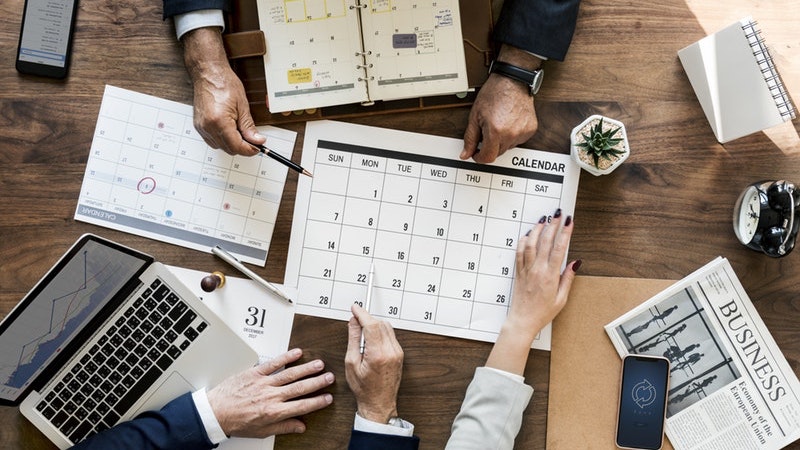Streamline Your Communication
Episode #6 of the course Streamline your life to have more time for what matters by Liz Huber
Welcome back!
Today, you’ll learn how to save time when communicating with other people.
Just a little reminder: What you choose to optimize is entirely up to you. The goal is not to implement every single strategy in this course, but to choose what fits best for you.
Analyze
Let’s start by analyzing your communication habits:
• What type of meetings and calls do you regularly attend?
• Which channels do you use for digital communication (email, WhatsApp, etc.)?
• How much time do you spend on each communication stream?
Eliminate
Eliminating unnecessary communication can be a great time saver. Here are examples:
Interruptions:
• Use an implicit signal like putting your headphones on to show that you should not be disturbed.
• Agree on “no-distraction” times with your team that will be kept meeting- and interruption-free. Furthermore, define which topics classify as “urgent” enough to interrupt someone else.
Meetings:
• Don’t attend meetings where your presence is not absolutely necessary.
• Cancel unnecessary meetings entirely (e.g., if there is no decision to be made).
• Replace meetings with email if they are for information purposes only and with phone calls if the issue can be resolved quickly.
• Reduce meeting frequency (e.g., do bi-weekly team meetings instead of every week).
Emails and messages:
• Consolidate accounts and channels by deleting or forwarding unnecessary email addresses, merging all your email addresses into one mailbox, and choosing only one channel for private messages. Only share contact information for the channels you want to be contacted on. You can also use IFTTT to send you messages from other channels to Slack or Skype.
• Ask to be taken off irrelevant email groups and leave chat groups that are not relevant anymore.
• Set up email rules with your team that will reduce email influx for everyone:
○ Think twice before sending an email. Is it necessary to send this now, or can it wait until the next team meeting?
○ Only send the email to people who need to respond. Avoid “reply to all.”
○ Don’t just forward an email without a summary and action points.
Calls:
• Don’t share your phone number in your email signature, business card, and in public directories.
• Let every call go to voicemail, with a recorded message saying that they should send you an email instead.
Bonus Tip: When you delegate tasks to other people, set up standard operating processes for a task so there is no need to come back to you with questions!
Optimize
Now, let’s look at optimizing the communication streams you can’t eliminate. Here are a few tips:
Meetings and calls:
• Set a clear agenda and outcome for the meeting and stay on topic.
• Only invite people who are absolutely needed.
• Make 20 minutes your default meeting duration.
• Wrap up with a summary, clear action steps, responsibilities, and deadlines.
• Combine your lunch and commute with meetings or calls.
• Do (video) calls instead of meetings to avoid unnecessary travel.
Emails:
• Schedule two to three daily time slots for attacking your inbox and messages, and turn off all notifications.
• Use the OHIO method: Only Handle It Once! Take care of urgent things right away, delegate less important things, delete irrelevant things, archive for-reference emails in specific folders, and use a tool like Boomerang to bounce emails back to your inbox for later follow-up.
• Use templates for email replies that occur more frequently.
• Agree on additional email rules with your team to increase efficiency:
○ Be clear and concise—the shorter, the better.
○ Stick to one topic per email.
○ Start long emails with a quick summary before getting into the details.
○ Highlight important information in bold.
○ Give clear action points with timelines and name the responsible person.
Automate
If you want to go a step further, you can use technology to automate some of your communication processes:
Use scheduling tools like Calendly and Doodle to avoid back-and-forth emails to find a meeting date.
Set up automatic email filters that pre-select important emails and archive the rest in specific folders for weekly review (Gmail automatically separates your inbox from newsletters and updates).
Use IFTTT to automatically share information. Some examples: send your partner a text message when you leave the office, post a reminder to Slack before a meeting, or automatically share an article when you apply a specific tag in Pocket.
Outsource
Finally, you can hire an assistant to manage all your communication (e.g., pre-filter your email, answer phone calls, coordinate appointments, etc.).
Take Action Today: Check your emails and messages only three times today!
Tomorrow, we will start optimizing your work!
Happy streamlining,
Liz
Recommended reading
The 15 Top Email Productivity Software Tools
What Happened to Me When I Said NO to Meetings for a Month
Recommended book
Simply Said: Communicating Better at Work and Beyond by Jay Sullivan
Share with friends

